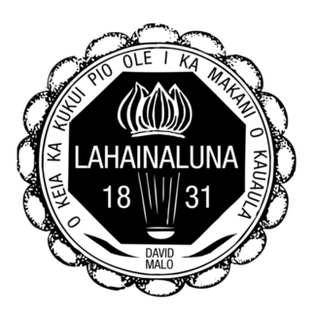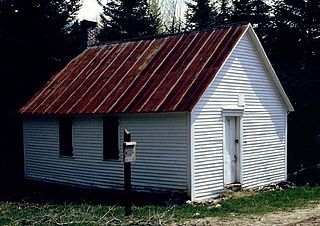
The Hana Highway is a 64.4-mile-long (103.6 km) stretch of Hawaii Routes 36 and 360 which connects Kahului to the town of Hana in east Maui. To the east of Kalepa Bridge, the highway continues to Kipahulu as Hawaii Route 31. Although Hana is only about 52 miles (84 km) from Kahului, an uninterrupted car-trip takes about 2.5 hours to drive, since the highway is very winding, narrow, and passes over 59 bridges, of which 46 are only one lane wide. There are approximately 620 curves along Route 360 from just east of Kahului to Hana, almost all of it through lush, tropical rainforest. Many of the concrete and steel bridges date back to 1910 and all but one are still in use. That one bridge, badly damaged by erosion, has been replaced by a portable steel ACROW or Bailey bridge erected by the United States Army Corps of Engineers.

Kaupō is a district of ancient Hawaii of Maui island in Hawaii. Kaupō is a remote, sparsely populated, sustainable ranching community.

Kīpahulu is an unincorporated community in the Hāna district of southeastern Maui, Hawaiʻi.

This is a list of properties and historic districts in Hawaii listed on the National Register of Historic Places. More than 370 listings appear on all but one of Hawaii's main islands and the Northwestern Islands, and in all of its five counties. Included are houses, schools, archeological sites, ships, shipwrecks and various other types of listings. These properties and districts are listed by island, beginning at the northwestern end of the chain.
This National Park Service list is complete through NPS recent listings posted September 5, 2024.

Lahainaluna High School is a public high school with the grades 9-12 located in Lahaina. Lahainaluna High School is also a public boarding school. It was founded in 1831 as a Protestant missionary school, originally named Lahainaluna Seminary. The early missionaries who arrived in Lahaina in 1823 explained to the Hawaiian Royalty the importance of an educational institution in the American style.
Maui High School is a public high school founded in 1913 in Hamakuapoko, a sugarcane plantation town on the island of Maui in Hawaii. In 1972, the school moved to its new location in Kahului, Hawaii.

The ʻĪao Theater is a Spanish Mission style theater opened in 1928, in the city of Wailuku, Maui, Hawaii. It was originally both a movie and vaudeville house, until it fell into disrepair in the 1980s. Facing possible demolition, in 1994, it was listed on the State of Hawaii's Register of Historic Places. It was placed on the National Register of Historic Places in 1995. It later became the home of Maui OnStage, a community-based theatrical organization.

The Wo Hing Society Hall was a building located at 858 Front Street in the Lahaina Historic District in Lahaina, Hawaii. Built around 1912, it served the growing Chinese population centered in Lahaina, primarily those working in the sugarcane industry as a social and fraternal hall for the Wo Hing Society. By the 1940s the declining Chinese population in Lahaina slowly made the building redundant and the property was neglected.
At their peak, there were six Chinese Society Halls on Maui. Operated by the Gee Kung Tong Society, these halls were created to provide services to immigrant Chinese workers, mostly working for the sugarcane plantations. All provided religious and political help, in addition to mutual aid. Only the Wo Hing Society Hall in Lahaina and the Ket Hing Society Hall in Kula have survived. Both were placed on the Hawaii State Register of Historic Places on July 30, 1982, and placed on the National Register of Historic Places on November 15, 1982. The Chee Kung Tong Society Hall was placed onto both State and Federal registers, but collapsed in 1996.

Loʻaloʻa Heiau is located in Kaupo on Maui. It is one of the few remaining intact examples of a large luakini heiau. Once the center of an important cultural complex, oral tradition attributes the construction of the temple at about 1730 AD to Kekaulike, King of Maui, who lived at Kaupo and died in 1736. Its site number is HASS-50-MA-A28-1. It was excavated in 1931. It was designated a National Historic Landmark in 1962.

Lahaina Historic District is a National Historic Landmark District encompassing most of the community of Lahaina, Hawaii, on the west side of the island of Maui in the US state of Hawaii. Designated in 1962, the district recognizes Lahaina for its well-preserved character as a 19th-century port, and for its social and economic importance in the 19th century as a major whaling center in the Pacific, and as one of the capital cities of the Kingdom of Hawaii.

Holy Ghost Catholic Church, also known as Holy Ghost Mission, is an historic octagon-shaped Roman Catholic church building on the island of Maui, located at 4300 Lower Kula Road in Waiakoa in the Kula district. It was designed by Father James Beissel and built by his parishioners who were Portuguese from the Azores and the Madeira Islands who had come to work on the local sugarcane plantation. The first mass was celebrated in it in 1895. It was consecrated in 1899 by Bishop Gulstan Ropert, the third vicar apostolic of the Vicariate Apostolic of the Sandwich Islands — now the Roman Catholic Diocese of Honolulu.

Keʻanae is an unincorporated community in Maui County on the island of Maui in the U.S. state of Hawaii. Keʻanae is a peninsula best known for being one of Hawaii's major taro farm growing regions. Keʻanae shares the zip code of 96708 with Haʻikū. The peninsula was originally made from lava that originated from Haleakalā Crater. The area currently attracts photographers and fishermen from all around the world. Although Keʻanae is known for its scenic peninsula, it is dangerous to swim along the shore due to its sharp lava rocks.
Hāna High and Elementary School is a public school in Hana, Hawaii. A part of the Hawaii Department of Education (HIDOE), it was established in 1912 and serves kindergarten through twelfth grade.

Hawaii Route 31, also known as the Pi'ilani Highway, is a 38-mile road on the island of Maui in Maui County, Hawaii, United States.

Waiola Church and Cemetery in Lāhainā is the site of a historic mission established in 1823 on the island of Maui in Hawaiʻi. Originally called Waineʻe Church until 1953, the cemetery is the final resting place for early members of the royal family of the Kingdom of Hawaii.

The Fred Baldwin Memorial Home was built in 1910 and endowed by Emily and Henry Perrine Baldwin to provide housing for elderly Hawaiian and haole men. It is named for their son Fred Baldwin (1881-1905). Its architect was H. L. Kerr, who had earlier designed the Old Wailuku Courthouse. In 2011, it was restored by Xorin Balbes to operate as an educational retreat named Lumeria Maui. It was added to the National Register of Historic Places on 1 December 2011.

The District No. 1 Schoolhouse is a historic one-room schoolhouse on Somerset Road in Somerset, Vermont, United States. Built about 1850, it is the only known entirely unaltered district schoolhouse in the state, and is probably the only surviving municipal building from the tiny community, which was disincorporated in 1937. The building was listed on the National Register of Historic Places in 1992.

Pāʻia Elementary School is a public elementary school in Paia, Hawaii, operated by the Hawaii Department of Education (HIDOE). Its original building is listed in the National Register of Historic Places along with five other Maui elementary schools.

Keʻanae School, later Keʻanae Elementary School, is a historic school building in Keanae, Hawaii, recognized by the National Register of Historic Places (NRHP). It formerly operated under the Hawaii Department of Education (HIDOE).



















